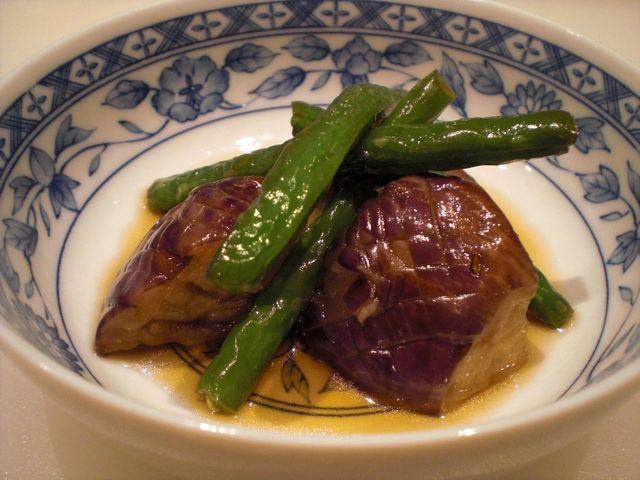(Based on the recipe in Mark's book p64)

This is one of the classic Japanese dishes--"Age-bitashi" 揚げ浸し meaning "fried and soaked". It is a very common Japanese cooking technique in which the ingredient is first deep fried and, while it is hot, soaked in a seasoned broth (aside from the usual soy sauce flavor, sometimes with added vinegar and/or hot pepper). Mark's book has this dish (p64), I only substituted green beans for the small Japanese green peppers "shishito" since I did not have "shishito". In the U.S., the types of eggplant "nasubi" 茄子 available are quite different from those in Japan. So called American eggplant "bei-nasu" 米茄子 is good for baked dishes such as eggplant parmesan or moussaka but not for this dish. I use a smaller eggplant with a thiner skin. Chinese or Japanese (elongated light or dark purple), or small Italian eggplants work best.
This is one of the classic Japanese dishes--"Age-bitashi" 揚げ浸し meaning "fried and soaked". It is a very common Japanese cooking technique in which the ingredient is first deep fried and, while it is hot, soaked in a seasoned broth (aside from the usual soy sauce flavor, sometimes with added vinegar and/or hot pepper). Mark's book has this dish (p64), I only substituted green beans for the small Japanese green peppers "shishito" since I did not have "shishito". In the U.S., the types of eggplant "nasubi" 茄子 available are quite different from those in Japan. So called American eggplant "bei-nasu" 米茄子 is good for baked dishes such as eggplant parmesan or moussaka but not for this dish. I use a smaller eggplant with a thiner skin. Chinese or Japanese (elongated light or dark purple), or small Italian eggplants work best.
Here I used a medium-sized light purple striped eggplant called "graffiti" eggplant. In any case, I cut the eggplant into 1x1 inch size pieces and then made shallow criss-crossing scores on the skin (hatch marks). This makes the skin more palatable and allows the broth to soak in better. I sprinkled the pieces with a small amount of salt and placed them in a colander for 15 minute. I then wiped the surface with paper towels to remove the salt and moisture. Meanwhile, I trimmed both ends of the green beans (10-15 or whatever amount) and wiped the surface dry with a paper towel.
I made the broth from a commercial concentrated noodle broth in a bottle but, of course, you could make this from scratch according to the recipe in Mark's book. I diluted the concentrate to taste (slightly stronger than that for broth for noodles, i.e., for the x2 concentrate, I diluted to x1.5) with cold water and then warmed it up and set aside in a flat sealable container.
I heated the peanut oil in a pan to about 340F (170C). I made sure both green beans and eggplant were dry (using paper towels) to prevent spattering when they were put into the hot oil. I fried the green beans first for 1 minute and put them on a paper towel to drain and the put them in the broth. Next, I fried the eggplant. Skin side down first then turned them over several times for 4-5 minutes until the meat of the eggplant becomes slightly brown and cooked through. I drained the eggplant on a paper towel and placed them in a colander. I poured hot water over them to remove excess oil. Then, I put the eggplant in the broth with the green beans. I let it cool down to room temperature and then put into the refrigerator. It is best to leave it for at least 30 minutes or overnight before serving.
This dish has subtle flavors but the eggplant is very rich and has a nice soft texture. This is a very nice dish with sake.


